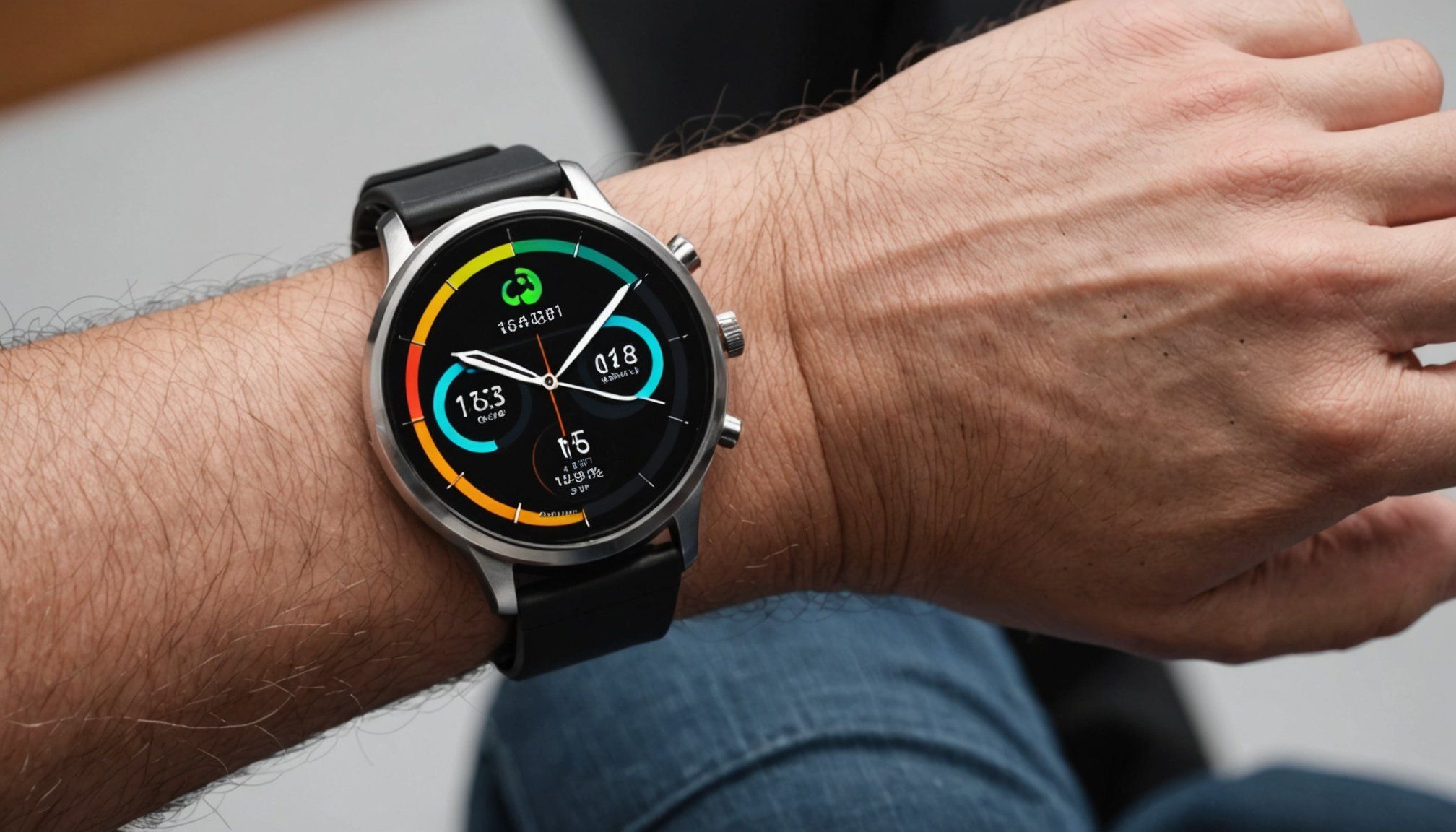Overview of Smart Watch Technology
Smart watches have revolutionised wearable technology with features like blood oxygen monitoring. These devices use advanced sensors to gauge health metrics, providing insights directly at your wrist. Blood oxygen levels, crucial for assessing respiratory function, are measured through techniques similar to those used in clinical settings.
The technology involves light sensors that detect the amount of oxygenated blood by examining the light absorption in blood vessels. This process, non-invasive and convenient, empowers users to frequently monitor their health without appointments or interruptions to daily life.
Also to read : Revolutionizing Legal Document Review: How AI Algorithms Drive Unprecedented Efficiency
User-friendly interfaces supplement this wearable technology by displaying data in easily digestible formats. Clear, intuitive interfaces are essential for interpreting health metrics correctly. They help users make informed decisions about their health and potentially identify issues that require professional medical advice.
Smart watches continue to evolve, integrating new health monitoring capabilities beyond simply tracking steps or exercise. Enhanced connectivity allows these devices to sync data with health applications, providing a comprehensive picture of one’s wellbeing over time.
Have you seen this : Prolonging Lifespan: Can Ultrasonic Cleaners Boost Medical Instrument Durability?
Implementing these features in everyday life signifies a step forward in personalised healthcare, giving individuals the tools they need to stay informed and proactive about their health.
Current Research and Future Developments
In the ever-evolving realm of smart watch technology, researchers are continually pushing boundaries to enhance the accuracy of health metrics. Recent studies have delved into the capabilities of smart watches, focusing on refining sensors that measure blood oxygen levels. These investigations aim to match the precision of traditional methods like clinical pulse oximeters.
One innovation on the horizon involves integrating advanced algorithms that compensate for variables such as skin tone and movement. These algorithms promise to provide more consistent and reliable readings across diverse user demographics, addressing a common barrier in the technology’s accuracy.
Furthermore, tech companies are exploring ways to embed more sophisticated sensors within smartwatches, potentially revolutionising onboard health diagnostics. These advancements reflect a commitment to overcoming current limitations and accentuate the transformative role of smart watches in personalised healthcare.
Looking ahead, experts predict an era where wearable technology won’t just monitor but will also forecast health trends. This future, powered by AI-driven insights, could redefine preventative care, allowing users to preemptively address health issues. As technology and research progress hand-in-hand, the potential implications for healthcare and personal well-being are boundless.
Accuracy of Smart Watches vs. Clinical Measurements
The exploration of accuracy in smart watches, specifically regarding blood oxygen levels, is an intricate field. Smart watch readings, although convenient, often fall short when compared to clinical measurements with traditional pulse oximeters. Research continues to assess these differences, as clinical instruments are naturally more robust given their specialised design for precise health metrics.
Key research findings highlight that smart watch accuracy may be influenced by several factors—chiefly the sensor technology and the individual’s skin tone, movement, or environmental conditions. While strides are being made in improving sensor robustness, these variables can still skew data interpretation.
Emerging studies suggest a positive trajectory in reducing gaps between smart watches and clinical standards. Technology advancements see innovative sensor integration that seeks to emulate clinical accuracy more closely. Improved algorithmic adjustments react to external conditions to refine data precision. These efforts signify a potential shift towards more dependable health monitoring in wearables. However, until then, users must remain informed of these limitations and interpret smart watch data critically when considering their health decisions.
User Experiences and Case Studies
Delving into user experiences and case studies provides a clearer picture of how individuals interact with smart watch blood oxygen monitoring features. Personal testimonials often reveal varied outcomes, with some users praising the convenience and others noting discrepancies when comparing data with clinical results.
Consider a case study where an individual’s smart watch consistently reports lower blood oxygen levels than those measured in a clinical setting. Investigations usually attribute these discrepancies to factors such as improper watch fit, skin tone variations, or movement during measurement. These insights underline the importance of understanding device constraints and encourage critical evaluation of data.
Another compelling aspect is how individuals interpret data reliability across different user demographics. Younger users might focus on fitness insights, while older individuals may rely extensively on these metrics for health monitoring. The variation highlights diverse expectations and needs from smart devices, stressing the importance of device reliability and accuracy.
Comprehensive, real-world testimonials and case studies enrich understanding by showing how different users perceive and utilize this wearable technology. These experiences emphasize the necessity of user education and highlight areas where smart watch technology can improve in terms of accuracy and user satisfaction.
Limitations and Concerns
Among the limitations of smart watches in blood oxygen monitoring is the potential lack of accuracy. These devices, while convenient, face challenges in matching the reliability of clinical instruments. External factors like skin tone, ambient light, and motion can alter readings, leading to concerns about data precision. Individuals must consider these elements, understanding that smart watches may offer varied results under different circumstances.
Sensor technology in smart watches aims to provide accurate readings but often falls short due to inherent accuracy challenges. For instance, while seated indoors, results might differ compared to active activities outside. Users should remain aware that this technology, though advancing, is still maturing in comparison to clinical standards.
Another concern lies in users’ interpretation of data without adequate context or medical guidance. Without full awareness, individuals might over-rely on traits such as blood oxygen levels for health insights. This reliance can be mitigated by recognising smart watches as supplementary rather than primary diagnostic tools.
Awareness of these limitations can enhance the user experience, ensuring informed use of wearable devices for monitoring health. Making critical evaluations about their accuracy is key when navigating the ongoing advancements in smart watch technology.
Expert Opinions on Smart Watch Reliability
Recognizing the potential of smart watches for health monitoring, experts are rigorously assessing their reliability. Healthcare professionals stress the distinction between these devices and traditional medical instruments. Despite their convenience, smart watches are generally advised for general well-being rather than precise medical diagnosis.
Technology experts acknowledge the continuous advancements in sensor technology, aiming to narrow the accuracy gap with clinical standards. They focus on integrating sophisticated algorithms to enhance data reliability. These improvements signify a positive trajectory, yet understanding device limitations remains crucial.
The consensus among experts is that user education plays a critical role. By comprehending device capabilities and interpreting metrics appropriately, users can optimize smart watch benefits without over-reliance. This informed approach helps navigate the evolving landscape of wearable technology.
Healthcare professionals advocate for ongoing research and development to bolster accuracy. They propose that smart watches complement traditional healthcare services, assisting timely medical consultations. As technology advances, the balance between innovation and reliable health management remains a priority.
Expert opinions consistently emphasize blending practical insights with user-friendly interfaces, ensuring data is presented accessibly and interpreted responsibly. Emphasizing both potential and limitations, expert dialogue spearheads the seamless integration of smart watches into everyday health practices.



